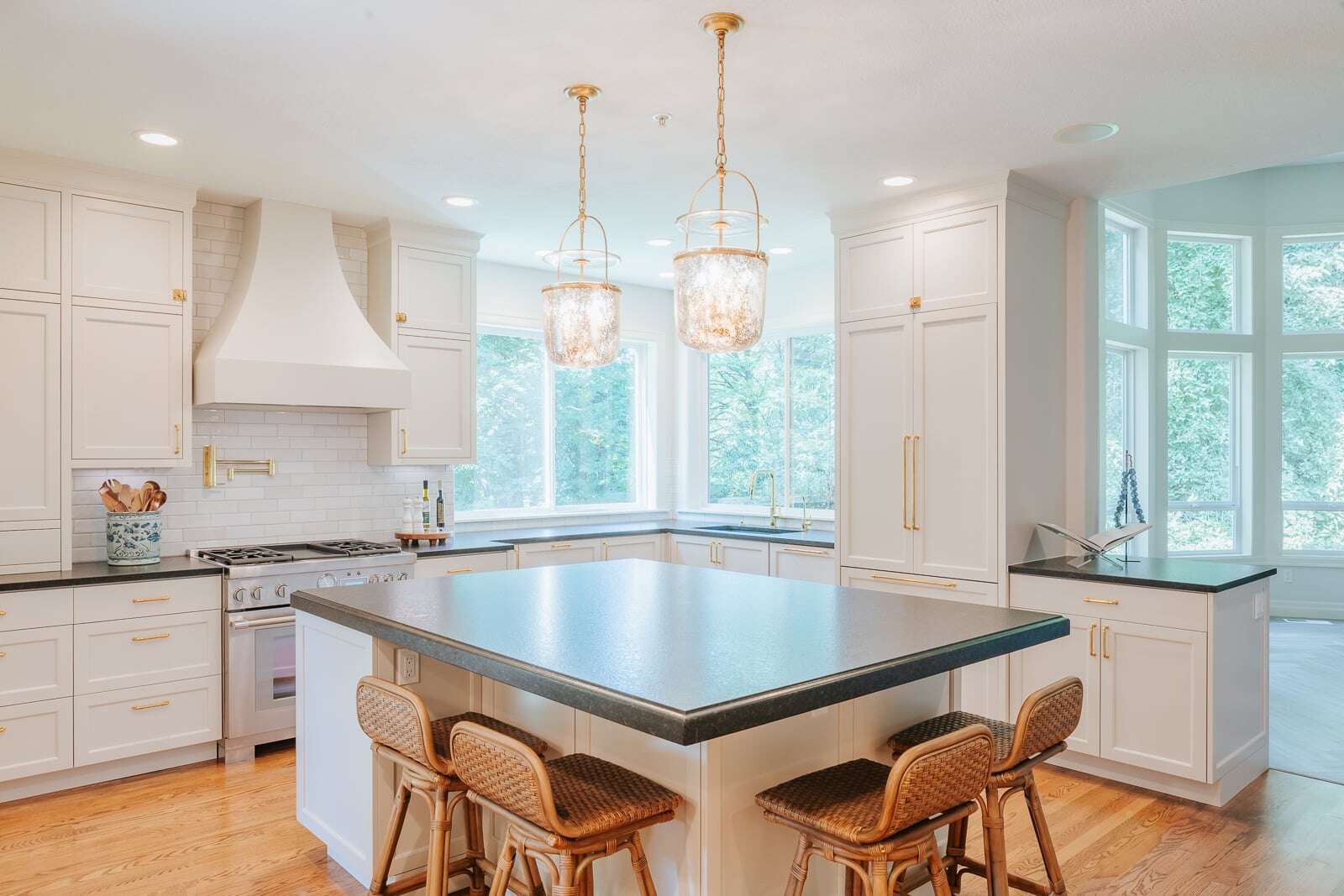One of the most influential – and often most challenging – choices a person can make in their kitchen is what type of countertop material they want. Often, this decision comes down to two popular options: granite and quartz. Though sometimes used interchangeably, there are several key differences between these two types of countertop materials which affect their style and application in a kitchen setting. If you want to understand the differences between granite and quartz, you’ve come to the right place.
At Lamont Bros. Design & Construction, we’ve worked with hundreds of Portland homeowners to transform their kitchens. When it comes to choosing a countertop, different materials serve different design and style preferences. Both granite and quartz can be great options for the right person, depending on how they use their kitchen. Choosing between the two is all about understanding which one is a better fit for your needs.
In this article, we’ll discuss the differences between granite and quartz, including the advantages and disadvantages of each. Once you’re done reading, you’ll have a better understanding of both options and be able to identify which one better suits your needs as a homeowner. The specific topics we’ll cover include:
- Pros and Cons of Quartz Countertops
- Pros and Cons of Granite Countertops
- How to Choose Between Quartz and Granite
Quartz Countertops: Sophisticated Design Meets Durability
While many people believe quartz countertops are cut from natural stone, quartz is actually a manufactured product made from natural stone. Quartz countertops are crafted from a blend of about 90% crushed quartz crystals and 10% polymer resins. The resulting slab creates a surface that rivals the beauty of natural stone with the enhanced functional qualities of engineered materials.
Quartz countertops have a consistent, predictable material quality thanks to the standardized manufacturing process. Additionally, they feature a broad spectrum of colors and patterns, ranging from subtle monochromes to elaborate designs with intricate color veining. The consistency in color and patterning from slab to slab is much more uniform than you’ll find with natural stone.


Pros of Quartz Countertops
Design Flexibility: With a wide range of colors and patterns, quartz offers unparalleled versatility in kitchen design. Styled correctly, quartz countertops can achieve everything from sleek, modern aesthetics to more traditional and classic visual styles.
Low Maintenance: The non-porous surface of quartz makes it antimicrobial and easy to clean. This reduces the risk of stains and bacterial growth without the need for regular sealing.
Predictable Pricing: The pricing of quartz countertops is more predictable due to the controlled manufacturing process. The cost is primarily influenced by controllable factors such as the clarity and purity of the quartz crystal used, as well as the complexity of the design and color.
Consistent Quality: Engineered for uniformity, quartz countertops deliver a consistent appearance across the entire surface, ensuring that your chosen design is exactly what you get. This can be especially valuable if you have a large kitchen that requires multiple slabs.
Cons of Quartz Countertops
Heat Sensitivity: Despite its durability, quartz can be susceptible to damage from high temperatures. This is due to the polymer binding agents present in the slab, which can melt if exposed to hot cookware.
Discoloration Risk: Exposure to UV light can cause discoloration or fading in the polymer components of quartz countertops. For outdoor spaces or kitchens that receive a lot of direct sunlight, this is an important factor to consider.
Visual Limitations: While quartz countertops offer a great balance of customizability and visual appeal, they don’t quite capture the unique, organic veining and patterns of natural stone.
Granite Countertops: The Allure of Natural Elegance
Granite, a natural and timeless countertop material, is an igneous rock extracted from the ground in quarries around the world. Each granite slab is distinct, showcasing a unique pattern and color palette created by nature itself. The natural stone is mined, cut into slabs, polished, and then transformed into countertops. Each piece is a one-of-a-kind work of art for your kitchen.
The draw of granite countertops lies in each slab’s natural beauty, durability, and uniqueness. Granite offers unparalleled richness in texture and color that only nature can provide. The variations in veining, speckles, and swirls in granite are one of a kind, ensuring that no two countertops are exactly alike.

Pros of Granite Countertops
Unique Aesthetics: Granite’s natural appearance individuality is its standout feature. Each slab offers a different pattern and color scheme, making it a favorite for homeowners seeking a distinct and upscale look in their kitchens.
Heat Resistance: Born from extreme conditions, granite is highly resistant to heat, making it a much more forgiving material when dealing with hot kitchen items. While you still shouldn’t set a pot off the stove right onto granite, it’s less likely to discolor or crack than quartz.
Long-Term Durability: Known for its hardness, granite resists scratches and wear, maintaining its stunning appearance for years. Its durability makes it a practical choice for busy kitchens where the countertops might face more abuse.
Cons of Granite Countertops
Regular Maintenance: As a natural rock, granite is porous and requires periodic sealing. Granite’s porosity means it can absorb liquids and stain if not properly sealed or if spills are left unattended.
Color & Style Limitations: While granite has a high visual appeal due to its natural qualities, there’s no way to customize the color or pattern. With granite, you get what comes out of the ground — it can’t be made to look exactly how you want it.
Price Variability: While the average cost of quartz and granite are comparable, granite varies more widely depending on factors such as rarity, origin, and color. This means that low-quality granite can be very cheap, while the cost of high-quality granite can be astronomical.
IV. How to Choose Between Quartz and Granite
When deciding between quartz and granite countertops, it’s essential to consider your lifestyle, aesthetic preferences, and budget. Here’s how to weigh these factors:
1. Consider Your Lifestyle and Usage
Think about how you plan to use your kitchen. If you know your kitchen is likely to see more wear and tear, you might prioritize durability and heat resistance, where granite has an edge.
However, if you prefer a low-maintenance kitchen, quartz is a strong contender due to its non-porous nature, requiring less upkeep than granite.
2. Aesthetic Preferences and Design Goals
It’s also important to consider the overall theme you envision for your kitchen. Quartz can lend a sleek and contemporary feel, while granite can add a touch of timeless elegance.
This is because quartz offers a wide range of colors and patterns, allowing for precise coordination with your kitchen’s design theme, whether modern or traditional. Granite, known for its unique and natural beauty, is more specifically attuned to a setting where you desire a natural, organic look.


C. Budget Considerations
Consider your budget not only in the context of the initial purchase but also for long-term maintenance. Granite might require continued investment in maintenance due to regular sealing, whereas quartz generally demands less in long-term upkeep.
Both quartz and granite can enhance the resale value of your home, but the choice may depend on market trends and buyer preferences in your area. Some buyers might be drawn to the natural allure and uniqueness of granite, while others may prefer the sleek, consistent look of quartz. If you’re focused on resale value, either one will add value to your home.
Ready to Learn More About Kitchen Remodeling?
Now that you have a better understanding of the difference between granite and quartz countertops, do you have a better idea of which one is right for your kitchen? As you continue exploring your options for your new kitchen, take some time to familiarize yourself with kitchen remodeling basics by downloading our free Kitchen Remodel Buyer’s Guide. In it, you’ll find remodeling best practices and insights directly from remodeling professionals.
Think it’s time to start designing your new kitchen? You don’t have to navigate the remodeling process alone. Click the button below to schedule a free design consultation with a member of our design team. We’ll help guide you through the ins and outs of remodeling as you turn your current kitchen into the kitchen of your dreams.



